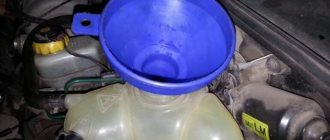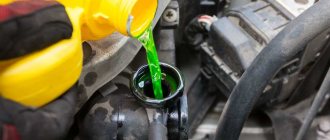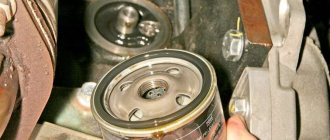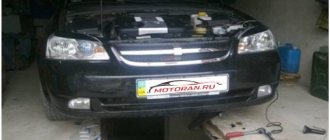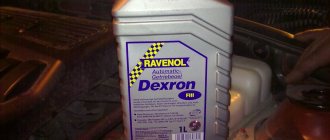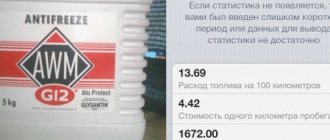The design of any car requires a cooling system. It helps to avoid overheating of the vehicle engine. One of its main components is coolant, which must be changed periodically. Timely replacement of antifreeze with Lacetti will ensure efficient engine operation. We will explain how the procedure is carried out in this article.
What kind of coolant is used
The cooling system of a Lacetti hatchback is operated together with high-quality antifreeze made from ethylene glycol. It is better to pour it into the expansion tank. Silicate is the main element in antifreeze, which is designed to serve as protection against rust.
Antifreeze is sold in concentrated form. If the old one is still flooded, then it should be removed from the tank. For this reason, before using the concentrate, add purified water in a 1:1 ratio. At low temperatures of −40 degrees and below, the liquid must be poured in a ratio of 3:2.
Tips for improving engine warm-up
In order for the car to be operated in optimal operating mode of the power unit, several rules must be followed:
- The car owner must monitor the quality of the cooling system. Periodic diagnostics require not only the thermostat and fan, but also the antifreeze itself. It is necessary to maintain its regulated quantity, avoiding minimum values. Air pockets must be removed from the system and any leaks must be eliminated. The coolant also needs timely replacement. The amount of its functional resource is determined individually for each individual model.
- Traveling in the cold season should be carried out in medium speed mode, at the level of 3000-3500. It is recommended to use a lower gear more often, especially when driving on the highway.
- An excellent solution would be to insulate the engine compartment. Even the presence of ordinary cardboard inserted in front of the cooling radiator can improve the situation. If the owner covers the engine compartment with porous materials or felt, the engine will warm up noticeably faster, and its natural cooling will no longer have a significant effect on operation.
Coolant color
Car owners who have not previously carried out the antifreeze replacement procedure often ask about the color of the liquid. Even experienced car enthusiasts often don’t know the answer. The opinion of most people is this: the color in which the cooling liquid is painted is an indicator of its technical properties. But it is fundamentally wrong.
It is worth remembering that the color of the coolant does not affect the technical qualities in any way. The opinion described above has taken root in the public consciousness due to the marketing moves of companies. Companies want their product to be different from similar products on the market made by competitors. Today you will find antifreeze on sale in various colors: from standard blue to gray-brown-crimson.
However, by the color of the liquid, you can determine the composition and dyes added to the mixture. The toxic neon tint of some of these products is a sign of the addition of an additive with fluorescent properties. It plays an important role in finding antifreeze leaks. By illuminating the space under the hood with ultraviolet light, the technician can easily determine the causes of the breakdown.
Many people use orange, yellow and red coolant. The service life is approximately five years or 200 thousand kilometers. It is the shade of the liquid that will help you distinguish the desired antifreeze with an increased service life from others.
What kind of oil to pour into a Chevrolet Lacetti engine
I tried a lot of things - Castrols and Mobiles, etc... But one day a good person recommended me the German ARAL oil. He filled it into his Mitsubishi Outlander immediately after replacing the factory one. This oil could only be purchased from a dealer in metal cans. At first I was quite skeptical about this proposal, but when he opened the filler neck and showed me the engine, I was certainly amazed! The mileage is 130 thousand km, and everything shines like new! And then my heart melted - I decided to try it, since my Lacetti has less mileage, and the engine, as it turned out, is “not like new” :)
Now I can say with confidence that I was not mistaken with my choice.
The engine has become much cleaner, of course the oil has darkened because of this, but not much, despite the mileage of 9000 km
Well, the choice of the manufacturer is a matter of... So choose for yourself.
Viscosity: 5w30, 5w40 and even tried 10w40. Now I'm stuck on 5w40
How often should you change antifreeze?
There are a number of recommendations regarding the issue of changing the refrigerant. The coolant should be changed every two years or after 30-40 thousand kilometers that the car has driven.
The antifreeze replacement time is determined based on the following characteristics:
- condition and mileage of the car;
- manufacturer;
- brand and quality of the cooling agent used;
- refrigerant that was previously used.
Liquids with silicate additives are changed every 2-3 years. The technical qualities of hybrid type antifreeze disappear within five years, and carboxylate type antifreeze remains for a period of 5 years or more, and replacement is not required.
At the moment, the market can also offer drivers carboxylate-based refrigerants that “work” for a mileage of 100 thousand kilometers or more. But such products are still few in number.
Expansion tank Lacetti
As soon as the water comes out of the tank after washing, then you can immediately dismantle it so as not to waste time. While the remaining water drains, you will easily have time to wash the tank.
To do this, use pliers to move the quick-release clamps securing the hoses to the tank and disconnect the hoses
There are only three hoses. We disconnect them and unscrew the two nuts securing the tank with a 10mm wrench.
Then forcefully lift the tank up and remove it.
Here are the mounting locations for the tank:
The mounting studs are circled, and the arrow shows the bracket onto which the tank fits tightly.
We wash the tank. Cleaning products for plumbing fixtures (toilets, etc.) help me with this. In particularly dirty cases, when oil has gotten into the coolant, you will have to wash it out with more aggressive means, even gasoline.
We install the tank in place.
Note. Do not lubricate the tank fittings with any lubricants. Even better, degrease them. The fact is that in the cooling system the pressure is higher than atmospheric pressure and hoses can fly off from lubricated or simply greasy fittings and the clamps will not hold them. A sudden leak of coolant can lead to dire consequences.
How much antifreeze is needed
Don’t go overboard with how many liters of antifreeze you pour into the Lacetti, and use exact numbers. Tank capacity - 7.2 liters. But you don't need to fill it out completely.
for Chevrolet Lacetti repair
I filled it with G11 (also from concentrate, it seems) it was about -20, I tried to start it... it worked and it started running through the tank. I dragged it into a warm box, it warmed up in a couple of hours, we drained this cocoa and filled it with Felix, everything is OK and the flight is normal.
Antifreeze cleaner AGA-R30 is designed for flushing cooling systems of gasoline and diesel engines of cars in normal operation. I filled in this miracle cleaner for a week in the hope of at least a little dissolving what was clogging the stove, but after driving only 250 km I discovered that the air flow had become almost hot. In terms of temperature, the heater return hose is in no way inferior to the inlet hose, and this cannot but rejoice. I plan to drive for a couple more days and go to replace the antifreeze with rinsing with distilled water and laurel.
Over time, the coolant loses its properties, so in order to maintain proper heat transfer of the Chevrolet Lacetti engine, it must be changed. The replacement operation is simple and anyone can do it with their own hands.
Required tools and materials
In order to change the coolant on a Chevrolet Lacetti, you will need the tools listed in the table below.
| Tools and materials | Note |
| Screwdriver | Flat blade |
| Coolant drain container | Volume up to 9 liters |
| Distilled water | Required for diluting concentrated antifreeze. |
| When changing the type of antifreeze, you must first flush the circuit with distilled water. This will require a liquid volume of 7 to 13 liters. | |
| Pliers | Can be replaced with pliers |
| Rubber tube | Diameter 10 mm |
Replacement frequency, what antifreeze to fill
The frequency of replacing antifreeze in a new car is regulated in the maintenance card. As for used cars, replacement should be carried out based on the recommendations of the coolant manufacturer.
For example, if you use original GM Dex-Cool Longlife coolant in a Chevrolet Lacetti, then replacement should be done every five years. This is exactly the period stated by the manufacturer, and also guarantees the preservation of all properties.
The original product is available in the form of a concentrate; its complete analogue is Havoline XLC. You can also use an analogue in the form of a finished product Coolstream Premium, produced at the Russian enterprise TECHNOFORM.
You can also pay attention to other manufacturers, for example, FELIX Carbox antifreeze has won good trust among car enthusiasts. The main thing to remember is that the color is just a dye, and the liquid must be selected according to tolerances. If the fluid has GM approval, then it can be used in the cooling system of this vehicle.
How much antifreeze is in the cooling system, volume table
| Model | Engine capacity | How many liters of antifreeze are in the system | Original liquid / analogues |
| Chevrolet Lacetti | gasoline 1.4 | 7.2 | Genuine General Motors Dex-Cool Longlife |
| gasoline 1.6 | Havoline XLC | ||
| gasoline 1.8 | 7.4 | Coolstream Premium | |
| gasoline 2.0 | FELIX Carbox |
Leaks and problems
The Chevrolet Lacetti cooling system does not have any serious problems, but when replacing it is worth paying attention to the condition of the pipes and clamps. If microcracks or swelling are detected, they should be replaced to prevent leakage in the future.
Some users sometimes report leakage from under the thermostat, which in most cases indicates wear of the gasket. There were cases of cracks in the expansion tank, which was also accompanied by a leak.
For reliable and long-term operation of the power plant, it is necessary to maintain its temperature within a narrow range. A cooling system is used to absorb and dissipate heat. Its working fluid is antifreeze. The life of the power unit depends on its timely replacement and compliance with recommendations for selection.
